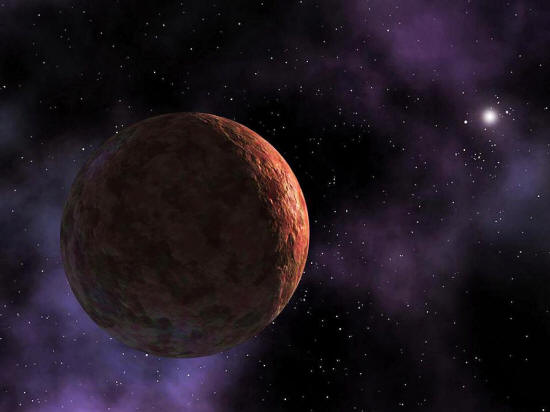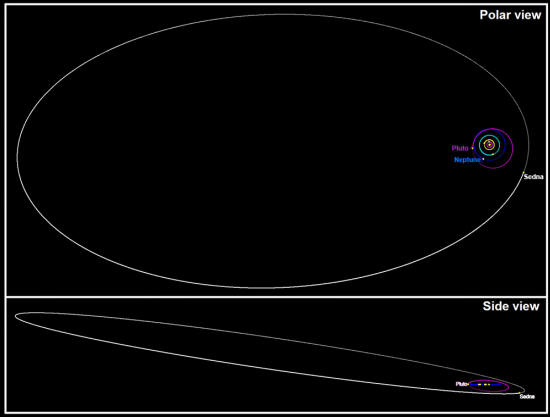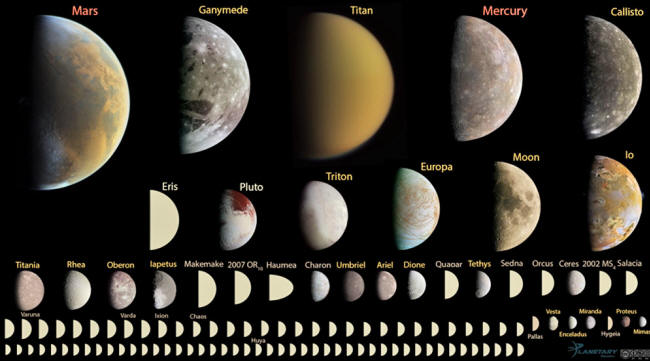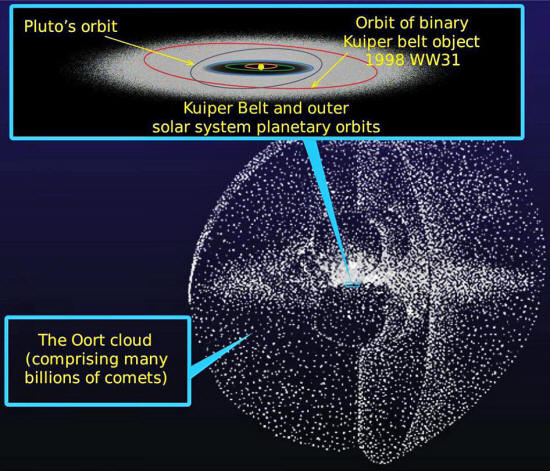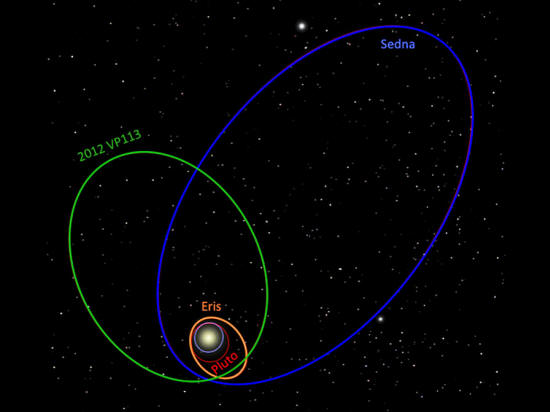|
from Medium Website
extending out all the way to the next-nearest stars, shows the extent of the asteroid belt Kuiper belt, and Oort cloud. While stars passing through the Oort cloud may be common, and were particularly common in the young days of the Solar System, it is unknown whether any of the objects we've discovered so far originate from beyond the Kuiper belt.
(NASA) the very first known object from the Inner Oort Cloud.
But time is running out to create and launch a mission.
While there were larger dwarf planets beyond Neptune, and comets that would travel farther from the Sun, Sedna was unique for how far it always remained from the Sun.
It always remained more than twice as distant from the Sun as Neptune was, and would achieve a maximum distance nearly 1,000 times as far as the Earth-Sun distance.
And despite all that, it's extremely large:
It's the first object we've ever found that might have originated from the Oort cloud.
And we'll only get two chances if we want to send a mission there:
Right now, there isn't even a proposed NASA mission looking at the possibility.
If we do nothing, the opportunity will simply pass us by.
which was the first completely detached object ever discovered. Sedna never approaches within 75 A.U. of the Sun, pointing towards a possible Oort cloud origin.
(NASA/JPL-Caltech/R. Hurt - SSC-Caltech)
There's the Kuiper belt, home to innumerable icy bodies, ranging in size from dwarf planets like Eris and Pluto down to comet-sized objects and even smaller.
Beyond that lies the scattered disk:
Going even farther out are detached objects:
But most distant of all would be objects originating from the Oort cloud:
Based on their orbital parameters, most of the objects from beyond Neptune fall into some well-known categories like the Kuiper belt or the scattered disk. Detached objects are rare, with Sedna perhaps the single most exceptional object of all for both its size and its orbital parameters. (Wikimedia Commons user Eurocommuter)
The Oort cloud has not yet been demonstrated to exist, although there are compelling theoretical and indirect observational reasons (such as the ultra-long-period or hyperbolically-orbiting comets we've found) to think it's real.
In theory, a spherically-distributed set of bodies that formed very early on, at the same time the Solar System did, should exist from around ~1000 A.U. away all the way to perhaps a light year or two.
In 2003, the team of Mike Brown, Chad Trujillo, and David Rabinowitz discovered the first candidate Oort cloud object: Sedna.
Sedna has an aphelion (its farthest distance from the Sun) of around 900 A.U., one of the most distant aphelia known. But its closest distance to the Sun (perihelion) is a very large 76 A.U.
Sedna never gets close enough to any of the major planets for a gravitational interaction to have scattered it.
Distant object 90377 Sedna, and its orbit, as seen from a top view and a side view with respect to the rest of the Solar System. Neptune's orbit is in blue; Pluto's is in red. This position is accurate as of January 1st, 2017. (Wikimedia Commons user Tomruen)
There's rampant speculation, therefore, that Sedna is the first object we've ever discovered originating from the Oort cloud.
In the 15 years that have passed since its discovery, only one more Sedna-like object has been discovered: 2012 VP113, with a perihelion of 80 A.U.
But the biggest difference is size-wise:
We were only able to discover Sedna because of how large and bright and reflective it is.
To date, it is the only detached object (or beyond) that was discovered by direct observation. And even at that, we only saw it because it happened to be quite close to perihelion, rather than aphelion, at the time of its discovery.
Under a size cutoff of 10,000 kilometers, there are two planets, 18 or 19 moons, 1 or 2 asteroids, and 87 trans-Neptunian objects, most of which do not yet have names. All are shown to scale, keeping in mind that for most of the trans-Neptunian objects, their sizes are only approximately known. Sedna is remarkable for being far and away the only one of these objects to achieve such a significant distance from the Sun. (Montage by Emily Lakdawalla. Data from NASA / JPL, JHUAPL/SwRI, SSI, and UCLA / MPS / DLR / IDA, processed by Gordan Ugarkovic, Ted Stryk, Bjorn Jonsson, Roman Tkachenko, and Emily Lakdawalla)
Sedna takes approximately 11,000 years to complete an orbit around the Sun, and is approximately about 85 A.U. away as of today.
It is moving closer to the Sun, and will reach perihelion in 2075. Owing to Sedna's size, orbital characteristics, and its origin, it is often considered to be the most scientifically important trans-Neptunian object ever discovered.
And if we choose to, we can send a mission to the outer Solar System to reach it as it nears its perihelion.
But due to the orbital particulars of all the planets in our Solar System, we really only get two chances. They're both coming up fast:
While the Oort cloud is hypothesized to exist in an enormous, sphere-like swarm, the Kuiper belt itself is still mostly plane-like, aligning with the invariable plane that the planets orbit in. The innermost reaches of the Oort cloud may be where objects like Sedna and/or 2012 VP113 originated. (NASA and William Crochot)
The reasons are simple.
Sedna's impending close approach means we will not get the opportunity to study it this close to the Sun for many millennia again. At present, there are no missions even under consideration by NASA to explore Sedna.
In order to get to Sedna, however, the most energy-efficient path would be to use a gravity assist from Jupiter, and there are only two windows where Earth, Jupiter, and Sedna are properly aligned to make such a launch:
If we choose one of these windows, we could arrive at Sedna after a journey of 24.5 years in space.
If we chose the 2033 launch, that would correspond to an arrival in late 2057, when Sedna will be 77.27 A.U. from the Sun. The 2046 window would get there in December of 2070, at a slightly closer 76.43 A.U.
Sedna achieves tremendous distances from the Sun, and takes more than 10,000 years to complete a single orbit. But despite reaching a maximum distance of nearly 1,000 A.U. from the Sun, it will come within 76 A.U. in approximately 2075. We have two windows to reach it prior to that event, owing to Sedna and Earth's alignment with Jupiter. (unmannedspaceflight.com user Lucas)
Think about everything we learned from the New Horizons mission.
We know what Pluto looks like, what its geology is, what its atmosphere is made of, about its various ices, compositions, the weather it experiences, the full extent of its lunar system, its topography, and much, much more.
We now understand more about how our Solar System formed and the young objects that formed in its outskirts than ever before.
And we did it with instruments that were designed and built in the early 2000s.
The dark (night) side of Pluto, showcasing layers of atmospheric haze and possible low-lying clouds (foreground) nearer to the surface. The technology that imaged Pluto is over a decade old; the technology that could be outfitted on a mission to Sedna would be a decade in the future. (NASA/JHUAPL/SwRI)
Now, imagine learning those same things about a whole new class of objects:
This is our best chance to explore what's possibly the most unique and serendipitous object that will pass close to our Sun for thousands of years, and if we ever believed in the spirit of space exploration, this is our golden opportunity.
Although Sedna was discovered way back in 2003, only one other object, 2012 VP113 (shown here), has been discovered that is classified as a Sednoid, and that possibly originates from the inner Oort cloud. Some people prefer the Planet Nine (ex-Planet X or 10) hypothesis, but that is a challenge for Sedna. (Scott S. Sheppard/Carnegie Institution for Science)
These are questions that, if we're curious about them, we could design and build a mission that gives us the answers.
Sedna won't be back for over 10,000 years, and it may be the largest, most distant object that we'll have the chance to have a close encounter with until its return.
Missions take a very long time to design, plan, and execute, particularly the most ambitious ones.
If we want to go in 2033, the time to start planning is now.
|



